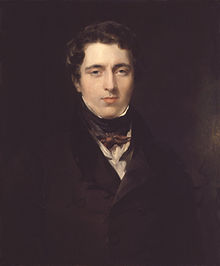Richard Parkes Bonington

Richard Parkes Bonington (born October 25, 1802 in Arnold near Nottingham , † September 23, 1828 in London ) was an important English painter from the period of the late classicism and the emerging romanticism. Despite his creative period of almost 10 years, he set new standards with his painting technique of watercolor painting, which made him a prize-winner at the Salon in France in 1824. His technique and style of representation and the contact with key figures of the École de 1830 make him a pioneer for the later Barbizon School .
life and work
His father was a drawing teacher and portrait painter. He exhibited oil painting landscapes and portraits at the Royal Academy in London in 1791 and 1808 and in Liverpool in 1811 and 1812. He also knew the art of watercolor painting and the creation of print templates. In order to be able to survive economically, he took on various professions in addition to painting. His mother, who had taken care of the upbringing of small children, married him in 1801. The only son was instructed in the arts and crafts at an early age. Because of the economic stagnation in England, the Boningtons moved to Calais in 1817. Before their arrival, Louis Francia crossed over to his hometown. He was a landscape and marine painter and continued his training, especially as far as marine painting was concerned. Eugène Delacroix is said to have met him in the Louvre. Around 1819 he is said to have copied paintings there under the guidance of his father. In 1819 he began to continue his training in Antoine-Jean Gros' studio . It was located in the Institute de France and enjoyed the highest reputation. In the mornings he was in the studio and in the afternoons he copied paintings in the Louvre - access to the École des Beaux-Arts was also open to Gros . His acquaintances from this time include such names as Auguste-Joseph Carrier , Pierre-Julien Gaudefroy and Henri Monnier . He also had good contacts with Eugène Lami , Camille Roqueplan and Paul Huet , who later joined the École de 1830. Here, too, his path crossed with Eugène Delacroix, who was a student of Guérin. As of 1821 September 1821 he was no longer enrolled. He lived off the sale of his work and took his friend Robert on a study trip to Normandy. His palette corresponded to the style of the first Watercolor Society of London.
In the Salon de Paris of 1822 paintings by Bonington were seen. As a lithographer , he illustrates Baron Taylor's Voyages pittoresques dans l'ancienne France and his own architectural series Restes et Fragmens . In the Salon of 1824 he was awarded a gold medal alongside John Constable and Anthony Vandyke Copley Fielding . A year later he travels with Delacroix to his homeland to study William Turner and English history painting. In 1828 Bonington died of tuberculosis in London.
In a letter to Théophile Thoré from 1861, Delacroix takes off his hat to the prematurely deceased, who nonetheless left behind more than 400 paintings and drawings. In watercolors, which was still a new art for the British at the time, Bonington had amazing skills. With all his masterful severity and precision, his brushwork shows a lightness that is unique, at least in contemporary art, which turns his works into a type of diamond that delights and flatters every eye.

Bonington's historical paintings are characterized by the careful study of contemporary models.
Aftermath
In Arnold and Nottingham there are several memorials for the gifted son of the city. However, there are also voices today who, despite their sympathy for Bonington, warn against a literal “romantic” transfiguration, and thus also overestimate.
literature
- Patrick Noon: Richard Parkes Bonington: "On the Pleasure of Painting". Yale University Press, 1991, ISBN 0-930606-67-1 .
- Matt Cambridge: Richard Parkes Bonington: Young and Romantic. Nottingham Castle, Nottingham 2002, ISBN 0-905634-58-6 . (Exhibition catalog; also contains texts about Bonington)
- Patrick Noon: Richard Parkes Bonington: The Complete Paintings. Yale University Press, 2009, ISBN 978-0-300-13421-6 . (contains 440 reproductions, detailed biographical and bibliographical information)

Individual evidence
- ↑ At first the painters were known under the name "École naturaliste" before they were later given the name "École de Barbizon".
- ↑ Meyer's Großes Konversations-Lexikon, Volume 3. Leipzig 1905, p. 204
- ↑ Patrick Noon 1991, p. 12.
- ↑ Stephen Bann: The Clothing of Clio. Cambridge 1984, p. 60.
- ↑ For more information, see Bonington Theater ( Memento of the original from June 12, 2008 in the Internet Archive ) Info: The archive link was inserted automatically and has not yet been checked. Please check the original and archive link according to the instructions and then remove this notice. , accessed February 20, 2011
- ^ About Silvae , accessed on February 20, 2011
Web links
- Literature by and about Richard Parkes Bonington in the catalog of the German National Library
- Biography and works on Tate Online
- Richard Parkes Bonington at artfacts.net
- Lecture by Robert Mellors, Nottingham 1909 , accessed February 20, 2011
| personal data | |
|---|---|
| SURNAME | Bonington, Richard Parkes |
| BRIEF DESCRIPTION | British-French romantic painter |
| DATE OF BIRTH | October 25, 1802 |
| PLACE OF BIRTH | Arnold , Nottinghamshire |
| DATE OF DEATH | September 23, 1828 |
| Place of death | London |
